Exploring the serene beauty of underwater worlds is pretty mesmerizing, and aquascaping with Java Moss, or Taxiphyllum barbieri, makes it feel like you’re painting with nature itself. This little gem from Southeast Asia, especially Vietnam, is more than just good-looking — it also does wonders for your tank’s ecosystem.
When I stumbled upon the “Java Moss Plant: Complete Care Guide in Aquariums,” I wasn’t the only one hooked; over 26,000 other hobbyists were too. That sparked my deeper dive into aquarium moss care. And let me tell you, the vibrant chat among enthusiasts about moss balls? Absolutely fascinating.
I’ve snagged stem plants for just $13 and decked out my tank with Vallisneria, and it’s been such a rewarding experience. Not only is it affordable, but it adds a lot to the overall feel of my tank. Of course, aquatic plants do need some love and know-how to thrive. For ideas and inspiration, I often find myself browsing aquariumplants.com and their stunning UK gallery.
One thing to keep in mind with Taxiphyllum barbieri is patience. It grows slowly, especially in low light, taking its time to stretch just a few inches. But that slow growth is actually perfect for my smaller tank creatures, like shrimp, that need a more controlled environment for breeding. Keeping the temperature between 70°F and 80°F and maintaining a pH level from 5.0-8.0 is key to keeping it healthy.
And Java Moss isn’t just about aesthetics — it’s super easy to propagate, which is another reason it’s a favorite. A quick trim and replant, and it keeps going strong. Plus, if you’re after faster growth, bumping up the light can work wonders, just like how a little extra sunlight can brighten up our own days.
The substrate matters too. Java Moss thrives in rich soils like flourite or eco-complete. It’s more than just a decoration—whether you’re mimicking a bit of Vietnam in your home or setting up a lush freshwater oasis, Java Moss plays a crucial role in your aquarium’s life.
Java Moss: A Home Aquarium Favorite
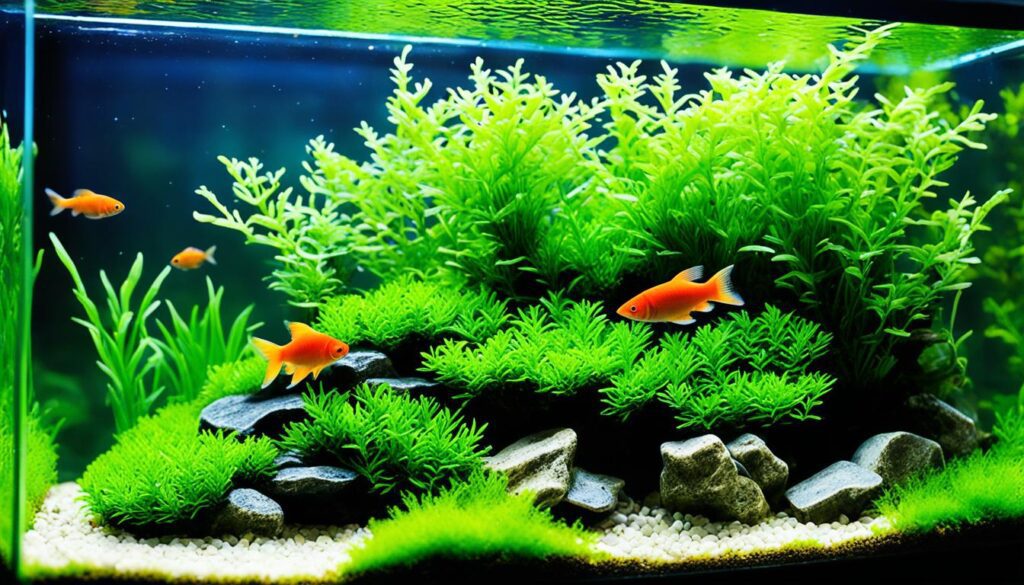
As someone who’s been in the aquarium hobby for a while, I’ve noticed Java Moss becoming a real favorite in home setups. It’s loved for its lush green look and versatility, making it perfect for beginners and seasoned aquascapers alike.
Java Moss is a bit of a tank superstar because it’s so resilient. It grows about 1-1.5 inches a month and can reach up to 4 inches. Its tiny fronds create these thick, carpet-like layers that not only make your tank look beautiful but also provide a fantastic environment for aquatic life. Those tiny critters that baby fish feast on? They love hanging out in the moss.
Taking care of it is a breeze—it doesn’t need special substrate and will stick to almost anything. With moderate lighting (around 10 hours a day), it thrives. Plus, it can adapt to various water conditions, handling temperatures between 70–75°F and a pH range of 5-8, which makes it excellent for improving water quality with minimal fuss.
Aquascaping enthusiasts love Java Moss for its versatility. You can shape it however you like—whether it’s growing up surfaces or spreading across them to form vibrant green carpets. And because it’s happy in both fresh and slightly salty water, it’s a hit with those who are all about design and ease.
Aside from its beauty, Java Moss works as a natural filter, catching debris and helping to improve water clarity. If you’re into breeding fish, it’s the perfect nursery for the babies. With its mix of good looks, easy care, and environmental benefits, Java Moss is a top choice for supporting aquatic life.
Java Moss: Origins and Unique Traits
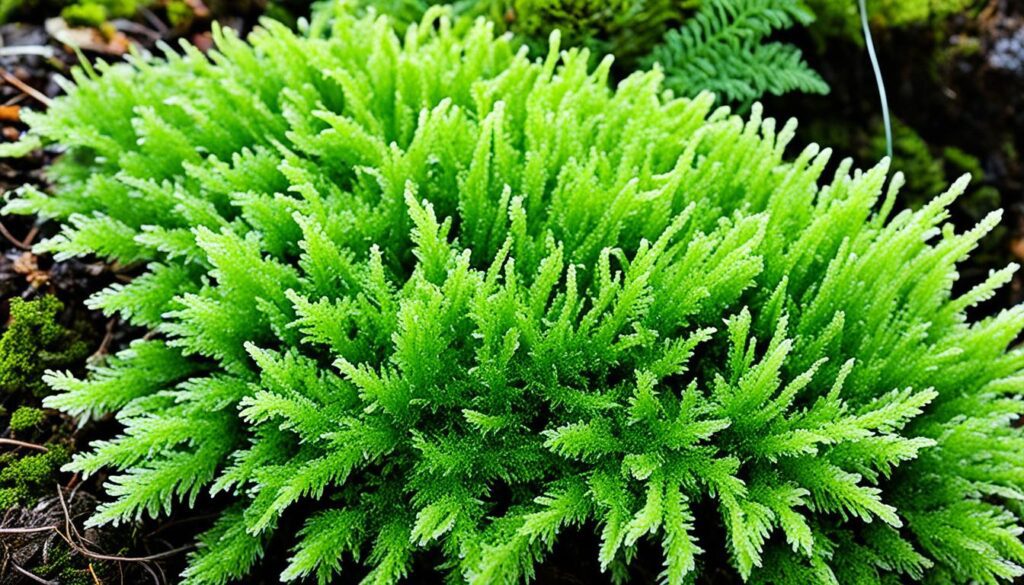
Southeast Asian native plant Taxiphyllum barbieri, is also known as Java Moss. It is a key player among aquatic mosses. It comes from places like Japan and Vietnam. Its easy growth and versatility make it a top choice for aquascaping.
Unveiling the Taxiphyllum barbieri Species
Taxiphyllum barbieri, often confused with Singapore Moss, is bright green. It has tiny, dense leaves. These create the famous java moss carpet that aquarists love. This plant adds beauty to tanks and helps with plant propagation.
Physical Appearance and Growth Patterns
Java Moss has fine, triangular-shaped moss and grows 1-1.5 inches monthly. It needs light for about 6-9 hours daily at 0.5 watts per liter. It does well in a pH range of 5.0-8.0. This makes it great for both new and experienced fish tank lovers.
Java Moss Versus Other Moss Species
Java Moss is easier to care for and grows stronger than Willow Moss and others. Here is a moss species comparison:
Characteristic |
Java Moss |
Willow Moss |
Singapore Moss |
|---|---|---|---|
Scientific Name |
Taxiphyllum barbieri |
Fontinalis antipyretica |
Vesicularia dubyana |
Growth Rate |
Medium |
Slow |
Medium |
Light Requirement |
Low to Medium |
Medium |
Medium to High |
pH Range |
5.0-8.0 |
5.0-7.0 |
6.0-7.5 |
Distinctive Trait |
Triangular-shaped leaves |
Rounded leaves |
Bladder-like vesicles |
Taxiphyllum barbieri, or Java Moss, is loved for its beauty and ease in care. It stands out in aquascaping for its toughness and ability to adapt. It’s a top pick worldwide for aquarium fans.
The Role of Java Moss in Aquarium Health and Aesthetics
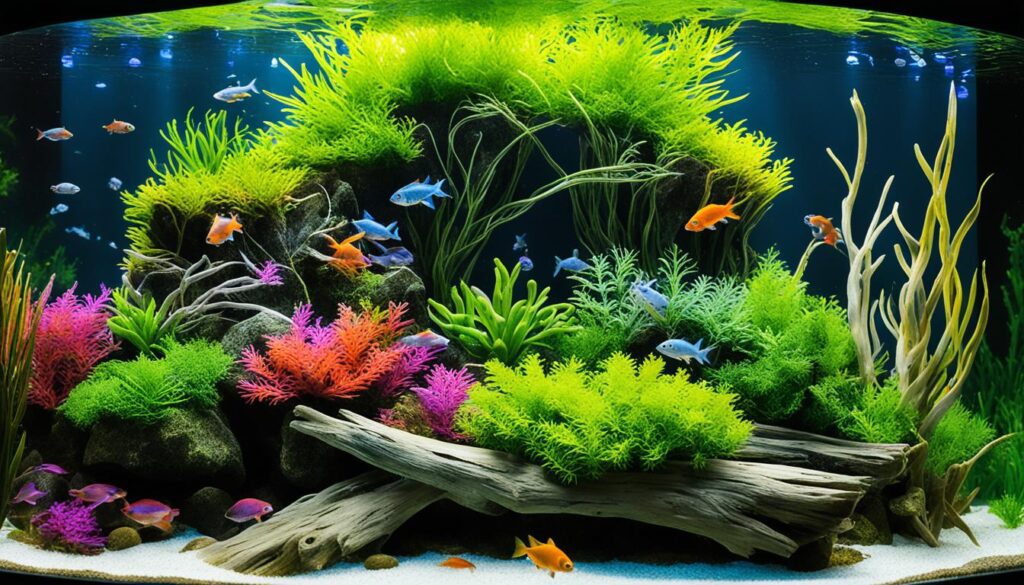
Java Moss is known as a great beneficial aquarium plant. It improves the health and looks of natural aquarium habitats. It’s not just pretty but also helps the water environment stay healthy.
One main benefit is oxygenation of aquarium water. This is key for keeping fish and other creatures alive. During photosynthesis, Java Moss makes oxygen which betters water quality. This makes a healthier home for all living in it. Also, its thick form is perfect for fish eggs to be laid on, aiding in breeding.
Java Moss also fights algae by competing for the same nutrients. This battle keeps the water cleaner and cuts down on tank cleaning. This is especially good for those who like an easy-care tank.
In terms of looks, Java Moss is a star in aquascaping. It can be shaped and adapted to many designs, boosting the beauty of the tank. It can be spread over rocks, wood, or made into green floors. This turns a simple tank into a stunning underwater scene.
Java Moss also handles different water temperatures and pH well. It grows in temperatures from 59°F to 86°F. It’s fine with a pH that’s a bit acidic to neutral. So, it’s perfect for both warm and cool water tanks.
So, Java Moss is more than a plant. It’s key to keeping an aquarium balanced, beautiful, and healthy. It’s a smart pick for both new and skilled fish tank lovers.
Java Moss: A Haven for Aquatic Life
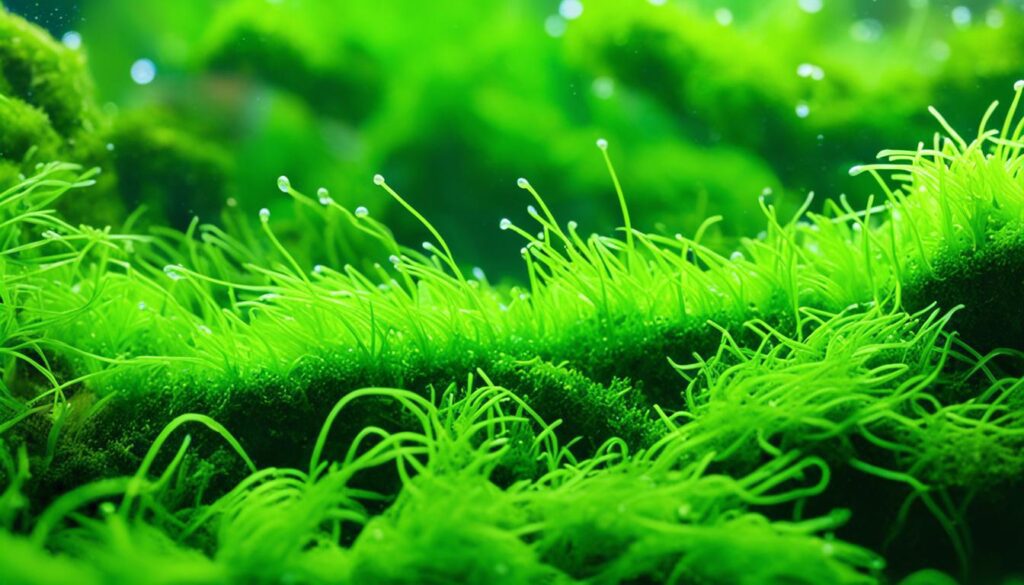
Java Moss, known scientifically as Taxiphyllum barbieri, is easy to take care of. It plays a key role in making a strong breeding environment in aquariums. This dense, bushy plant is perfect for a lot of aquatic life, especially in tanks for shrimp and young fish, known as fry.
Beneficial Qualities for Shrimp and Fry
Java Moss is crucial in a breeding tank’s ecosystem. It keeps shrimp and fry safe and fed. Its complex structure is like a maze, offering lots of hiding places. This helps protect them from predators. This plant is great for laying eggs and is full of microorganisms. These are essential for feeding newly hatched shrimp and fry.
Java Moss as a Natural Breeding Ground
Java Moss is a gem for those who love breeding fish. It makes tanks look good and helps fish breed naturally. Fish like Neon Tetras and Mollies use its safe spots for egg-laying. They trust Java Moss to care for their future offspring.
Providing Security and Nutrition to Fish
Java Moss is more than just a decoration. It’s crucial for a healthy fish home. Fish get nutrients from the plant and the microorganisms living on it. Java Moss supports a balanced diet. This is vital for the growth and health of fish in the tank.
Java Moss is a must-have for anyone wanting a natural and self-sustaining aquarium. It combines beauty with function in tanks for shrimp or fry.
Ideal Aquarium Conditions for Java Moss Prosperity

Getting the right light and water balance is key for Java Moss growth in your aquarium. This plant is tough and can adapt to different conditions. Yet, it does best when its specific needs are met.
Optimal water conditions are crucial. Java Moss thrives in water around 75°F, but can handle up to 86°F. Cooler water keeps it looking lush and vibrant. Also, the water’s pH should be between 5.0 and 8.0. This helps create a stress-free home for the moss.
In terms of tank water parameters, carbon dioxide is a big help. It speeds up Java Moss’s growth. This is because the plant uses carbon dioxide for photosynthesis. Keeping an eye on these parameters helps keep the tank right for Java Moss and other tank inhabitants.
Don’t forget about light requirements. Java Moss likes moderate to dim light for 8-10 hours daily. This light level is close to its natural, shady underwater habitat. The right lighting supports growth and keeps its green color bright.
Parameter |
Optimal Range |
|---|---|
Temperature |
70°F – 86°F |
pH Level |
5.0 – 8.0 |
Lighting Duration |
8-10 hours per day |
Carbon Dioxide Content |
High (for fast growth) |
Following these tips helps your Java Moss flourish. It also creates a healthy and beautiful environment for your aquarium.
Java Moss Plant Care and Maintenance
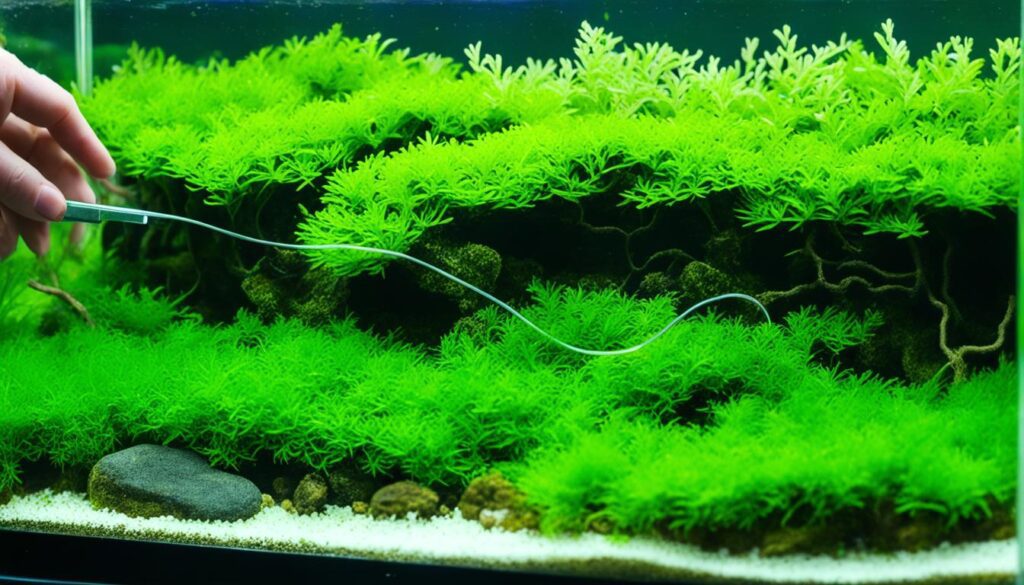
To care for Java Moss well, focus on aquarium plant trimming, pruning aquatic plants, and water quality management. These steps help the species thrive. They add beauty and help the ecosystem too.
Trimming Techniques and Frequency
Regular trimming keeps Java Moss looking good and healthy. With sharp scissors, I cut off extra growth. It controls its spread and thickness.
This is important for algae prevention. It keeps the light and nutrient balance right for the moss and tank mates. Trimming helps the moss grow well. It stops it from blocking light to other plants.
Managing Light and Water Quality
Java Moss lives longer with the right water conditions. I test the water every week. I check the pH, temperature, and hardness. I make adjustments to reach the best conditions. Java Moss does best in 70-75℉ and a pH of 5-8.
Good aquarium cleaning and nutrient balance lower algae risks. This is especially true under bright lights.
Algae Control Strategies
Unchecked algae can ruin Java Moss’s look. To fight this, balance tank light and nutrients. Add shrimp or snails that eat algae.
Sometimes, gently scrub the moss with a soft toothbrush. Or replace parts that have too much algae. It’s vital the moss gets the right amount of light. Too much or too little can cause algae to grow.
Talking with other aquarium lovers taught me about Java Moss’s toughness. It can bounce back strong after heavy trimming. Check out how it goes from thick mats to thin strands here. This shows the importance of care and natural growth. My care methods ensure this plant enhances the ecosystem, avoiding dominance.
Artistic Aquascaping with Java Moss
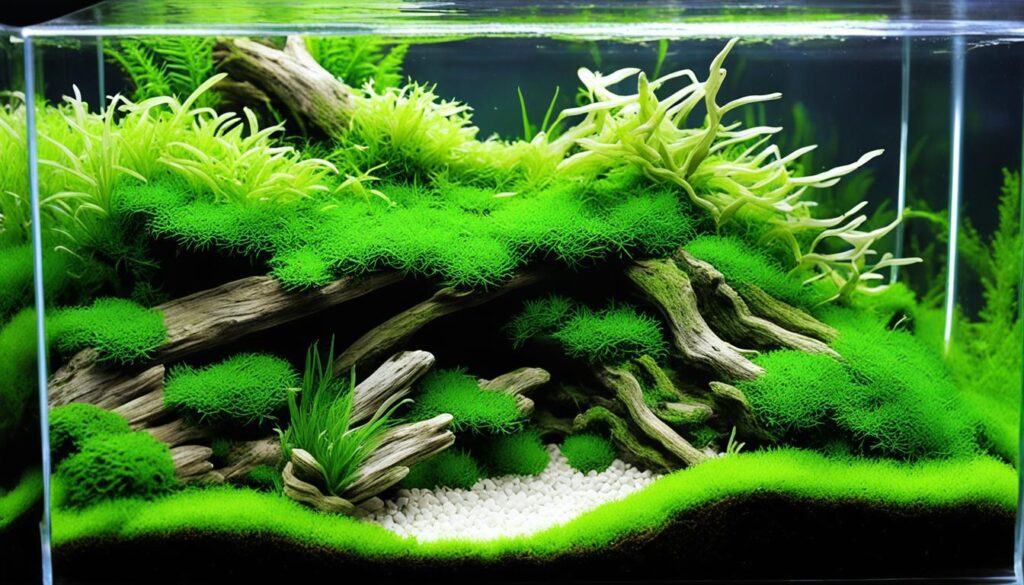
I love moss aquascaping, and I use Java Moss to boost creative aquarium design. This moss is super adaptable. It’s great for making natural aquatic decorations. This transforms a plain aquarium into something amazing. Knowing how to use this moss well can really change how your aquascape looks.
Switching from a 29-gallon to a 40-gallon tank, I aimed for an aquascape that was both biodiverse and visually stunning. Below, you’ll find the tools and techniques that many in the aquascaping world, including myself, swear by.
Material |
Utility |
|---|---|
Plastic Leaf Guard Gutter Mesh |
Used as a base layer for moss; provides fine texture for moss to latch on. |
Stainless Steel Wire |
Provides structural support; easily manipulated for creative designs. |
Zip-ties |
Secure mesh layers and other structural elements. |
I embrace certain aquascaping styles. My work is inspired by the Nature Aquarium style from Takashi Amano. It focuses on harmony and balance. I use special techniques to make my tanks look more spacious and peaceful. Most of my tanks use shadows and have a few focal points to catch the eye.
- The free-growing Java Moss on the mesh looks like real landscapes. It fits perfectly with driftwood and rocks.
- I try to mimic nature’s look and feel while keeping everything looking neat and together.
If you’re new to aquascaping or want to improve, using Java Moss and strong materials can lead to great projects. You can make anything from green carpets to tree shapes. Your imagination sets the boundaries in the rewarding hobby of moss aquascaping.
Practical Guide to Planting Java Moss
I love making underwater scenes look amazing. Java Moss is one of the simplest things you can use. I want to share how you can make a great Java Moss setup. I’ll also talk about planting techniques and how to get creative with your aquarium.
Anchoring Methods for Optimal Growth
Fishing line works best for tying Java Moss to rocks or driftwood. It’s strong and soon looks invisible. Securing the moss lets it grow over things like driftwood, adding a natural touch to your aquarium. Java Moss not only looks good but also helps keep the water clean by absorbing harmful stuff. It’s great for tiny water creatures too.
Creating Moss Carpets and Walls
To make a moss carpet or wall, I use a mesh. This lets the moss spread out nicely. It makes your aquarium look green and peaceful. It’s also good for baby fish and acts as food. Good lighting and water flow help these setups grow well. They show off how pretty Java Moss can look.
Designing Underwater Moss Trees
Creating moss trees is a fun project. You attach Java Moss to driftwood standing up. It looks like a water bonsai tree and draws a lot of attention. Keep it trimmed to look its best. If algae become a problem, I use Flourish Excel to keep it under control.
Java Moss can make your aquarium come alive, whether it’s a tree, carpet, or wall. With a little patience and creativity, it turns your space into a living piece of art. It adds beauty and is useful for your water friends.








